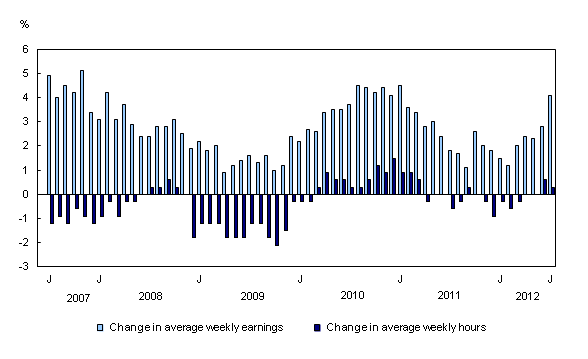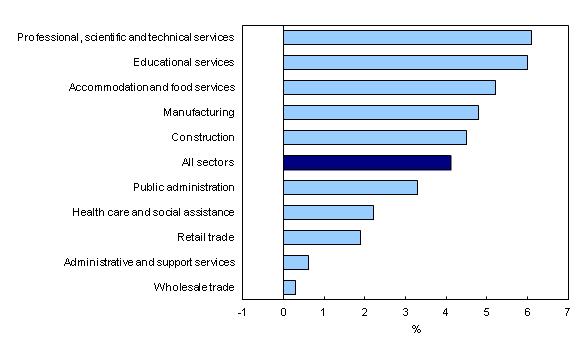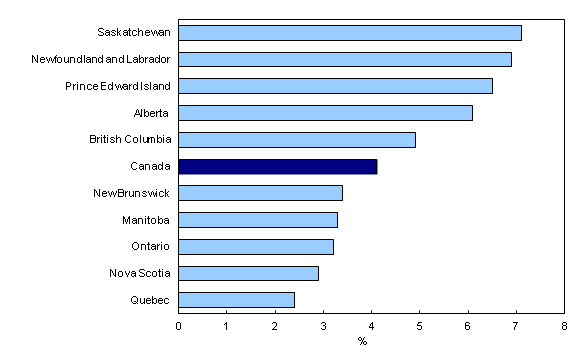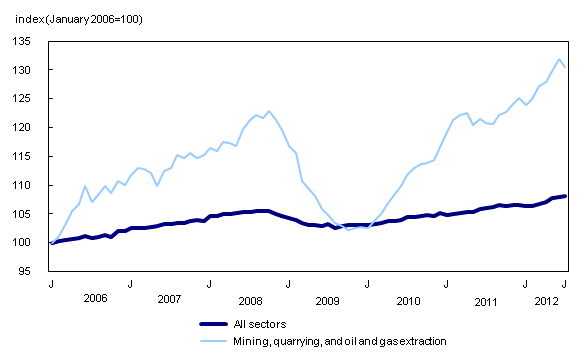Payroll employment, earnings and hours, July 2012
Archived Content
Information identified as archived is provided for reference, research or recordkeeping purposes. It is not subject to the Government of Canada Web Standards and has not been altered or updated since it was archived. Please "contact us" to request a format other than those available.
Related subjects
-
[an error occurred while processing this directive]
In July, average weekly earnings of non-farm payroll employees were $906.68, up 1.1% from the previous month. On a year-over-year basis, earnings increased 4.1%.
Year-over-year change in average weekly hours and average weekly earnings

Chart description: Year-over-year change in average weekly hours and average weekly earnings
The 4.1% increase during the 12 months to July reflects a number of factors, including wage growth, changes in the composition of employment, as well as average hours worked per week. In July, non-farm payroll employees worked an average of 32.9 hours per week, down from 33.1 the month before but up from 32.8 in July 2011.
Average weekly earnings by sector
Year-over-year growth in average weekly earnings outpaced the national average of 4.1% in five of the largest industrial sectors: professional, scientific and technical services; educational services; accommodation and food services; manufacturing; and construction.
Year-over-year change in average weekly earnings in the 10 largest sectors, July 2011 to July 2012

Weekly earnings in professional, scientific and technical services increased 6.1% to $1,279.82, with gains in all industries within the sector.
Average weekly earnings in educational services rose 6.0% to $1,010.22 over the 12 months, with all the growth in post-secondary as well as elementary and secondary schools.
Weekly earnings in accommodation and food services were up 5.2% to $377.30 in the 12 months to July. Increases were most notable in special food services and limited-service eating places.
In manufacturing, weekly earnings increased 4.8% to $1,012.30 in the 12 months to July, with the most notable growth among manufacturers of transportation equipment; paper; primary metal; wood products; machinery; as well as plastics and rubber products.
In construction, weekly earnings rose 4.5% to $1,133.10. Growth was widespread across most industries in this sector.
Average weekly earnings up in every province
Average weekly earnings of non-farm payroll employees increased in every province in the 12 months to July. Growth was highest in Saskatchewan, Newfoundland and Labrador, Prince Edward Island and Alberta.
Year-over-year growth in average weekly earnings by province, July 2011 to July 2012

In Saskatchewan, average weekly earnings were $929.31 in July, up 7.1% from 12 months earlier. These weekly earnings were among the highest of all provinces.
In Newfoundland and Labrador, average weekly earnings increased 6.9% to $934.21, also among the highest provincial earnings.
Average weekly earnings in Prince Edward Island were $762.67 in July, up 6.5% compared with 12 months earlier.
At $1,094.85 in July, average weekly earnings in Alberta were the highest among all provinces, up 6.1% from 12 months earlier.
Weekly earnings in British Columbia were $876.98 in July, up 4.9% from 12 months earlier.
Non-farm payroll employment by sector
Total non-farm payroll employment rose by 19,200 between June and July, the fifth consecutive monthly increase.
In July, increases in payroll employment were in retail and wholesale trade; professional, scientific and technical services; health care and social assistance; construction as well as transportation and warehousing. The most notable decline was in public administration.
On a year-over-year basis, payroll employment increased by 290,300 (+1.9%), with most of these gains since February 2012 (+237,400).
Among all sectors, mining, quarrying, and oil and gas extraction posted the highest 12-month growth rate in payroll employment, at 8.1% (see the "Sector profile" section of this release). It was followed by the construction sector (+4.6%); accommodation and food services (+3.4%); professional, scientific and technical services (+3.3%) and transportation and warehousing (+3.1%).
Sector profile: Mining, quarrying, and oil and gas extraction
From time to time, this release profiles an industrial sector or province with a notable trend. This month, we examine the mining, quarrying, and oil and gas extraction sector because of its faster-than-average growth in earnings, hours and payroll employment.
In July, there were 221,400 payroll employees in mining, quarrying, and oil and gas extraction, representing 1.4% of the national total. This compares with a share of 1.1% in 2001. The largest proportion of employees in this sector (44%) were working in support activities for mining and oil and gas extraction, which include services such as contract drilling, oil and gas well services and mine tunnelling.
Another 27% of employees worked in oil and gas extraction, while the remaining worked in metal ore mining (14%), non-metallic mineral mining and quarrying (10%) and coal mining (4%).
Provincially, Alberta (55%) had the largest share of employment in mining, quarrying, and oil and gas extraction, followed by Ontario (11%), British Columbia (10%) and Saskatchewan (9%).
In Alberta, the vast majority of employees in the sector were in two industries: support activities for mining and oil and gas extraction; and oil and gas extraction. In Ontario, most employees worked in metal ore mining; support activities for mining and oil and gas extraction; and non-metallic mineral mining and quarrying.
In British Columbia, employees in this sector were mostly working in support activities for mining and oil and gas extraction; metal ore mining; and coal mining, while employees in Saskatchewan were widespread in all industries, with the exception of coal mining.
The mining, quarrying, and oil and gas extraction sector was hit particularly hard by the economic downturn in 2008/2009. Its decline in payroll employees was sharper than for most other sectors.
Non-farm payroll employment in mining, quarrying, and oil and gas extraction, January 2006 to July 2012

After peaking at 208,200 payroll employees in October 2008, employment in this sector fell for 12 consecutive months, with a total decline of 16.8% to 173,300 employees. In comparison, the all-sector decline was 2.4%.
Between October 2008 and October 2009, most industries within the sector experienced notable job losses. The exception was coal mining, the industry with the fewest employees, which had relatively stable employment levels.
From October 2009 to July 2012, payroll employment in mining, quarrying, and oil and gas extraction increased 28%, compared with the 4.9% all-sector growth rate. As a result, by July 2012, the number of employees within the sector was higher than the previous peak in October 2008 by 13,200.
Average weekly earnings in mining, quarrying, and oil and gas extraction have been the highest of all sectors since 2007. Also, this sector had the fastest growth rate in earnings, up 11.7% in the 12 months to July to $1,916.46. The most notable growth in the sector occurred among employees in mining and quarrying, where average weekly earnings rose 21.5%.
Average weekly earnings in July were the highest in oil and gas extraction at $2,382.65, followed by mining and quarrying ($1,780.89) and support activities ($1,724.34).
Average weekly hours worked by payroll employees in mining, quarrying, and oil and gas extraction increased from 40.8 to 41.5 hours in the 12 months to July. This sector has the longest average workweek, well above the all-sector average of 32.9 hours in July. Employees in the mining and quarrying industry had the longest weekly hours worked in July (42.4), followed by support activities (41.7) and oil and gas extraction (40.3).
Note to readers
The Survey of Employment, Payrolls and Hours (SEPH) is a business census of non-farm payroll employees. Its key objective is to provide a monthly portrait of the level of earnings, the number of jobs and hours worked by detailed industry at the national, provincial and territorial level.
Statistics Canada also produces employment estimates from its monthly Labour Force Survey (LFS). The LFS is a household survey, the main objective of which is to divide the working-age population into three mutually exclusive groups: the employed (including the self-employed), unemployed and not in the labour force. This survey is the official source for the unemployment rate and collects data on the socio-demographic characteristics of all those in the labour market.
As a result of conceptual and methodological differences, estimates of changes from SEPH and LFS do differ from time to time. However, the trends in the data are quite similar.
Unless otherwise stated, this release presents seasonally adjusted data, which facilitates comparisons by removing the effects of seasonal variations. For more information on seasonal adjustment, see Seasonal adjustment and identifying economic trends.
Non-farm payroll employment data are for all hourly and salaried employees, as well as the "other employees" category, which includes piece-rate and commission-only employees.
Average weekly hours data are for hourly and salaried employees only and exclude businesses that could not be classified to a North American Industry Classification System (NAICS) code.
All earnings data include overtime pay and exclude businesses that could not be classified to a NAICS code. Earnings data are based on gross payroll before source deductions.
Average weekly earnings are derived by dividing total weekly earnings by the number of employees.
With each release, data for the current reference month are subject to revision. Data have been revised for the previous month. Users are encouraged to request and use the most up-to-date data for each month.
Data on the education sector
Changes in payroll employment in education during the summer months can be affected by changes in payment schedules and school-year calendars. Month-to-month changes should therefore be interpreted with caution, and more attention given to long-term trends.
Available without charge in CANSIM: tables CANSIM table281-0023 to 281-0039 and CANSIM table281-0041 to 281-0049.
Definitions, data sources and methods: survey number survey number2612.
A data table is available from the Key resource module of our website under Summary tables.
Detailed industry data, data by size of enterprise based on employment, and other labour market indicators will soon be available in the monthly publication Employment, Earnings and Hours, Vol. 90, no. 7 (Catalogue number72-002-X, free).
Data on payroll employment, earnings and hours for August will be released on October 25.
For more information, contact Statistics Canada's National Contact Centre (toll-free 1-800-263-1136; 613-951-8116; infostats@statcan.gc.ca).
To enquire about the concepts, methods or data quality of this release, contact Jeannine Usalcas (613-951-4720; jeannine.usalcas@statcan.gc.ca), Labour Statistics Division.
- Date modified:
